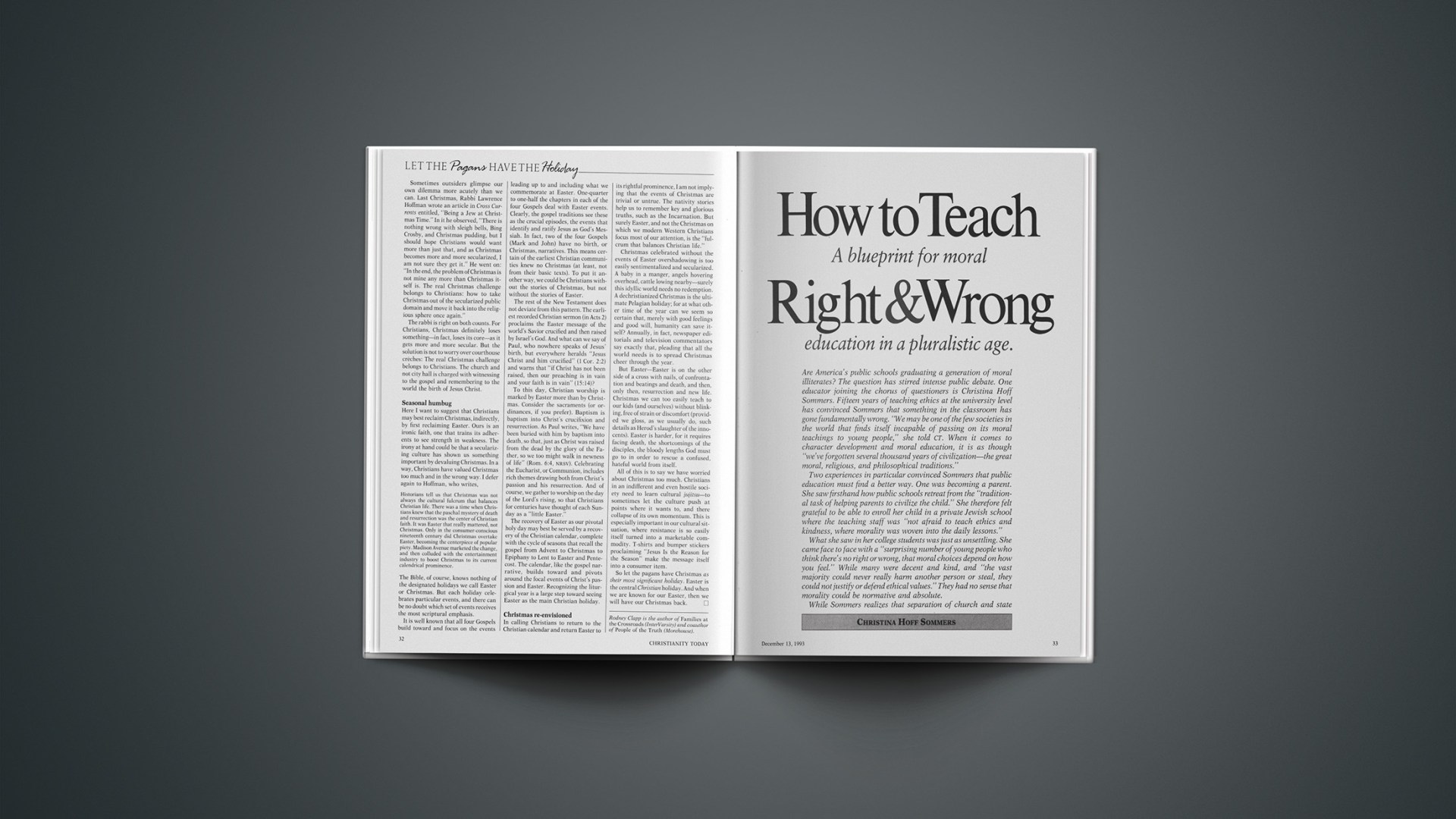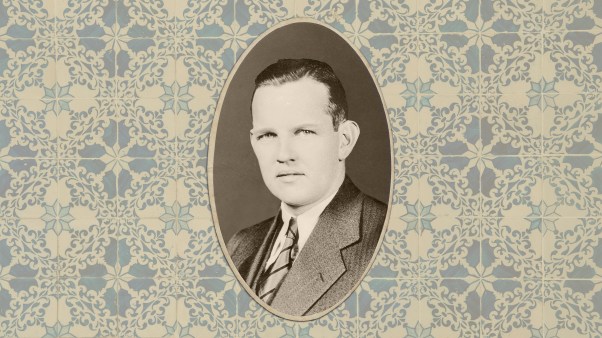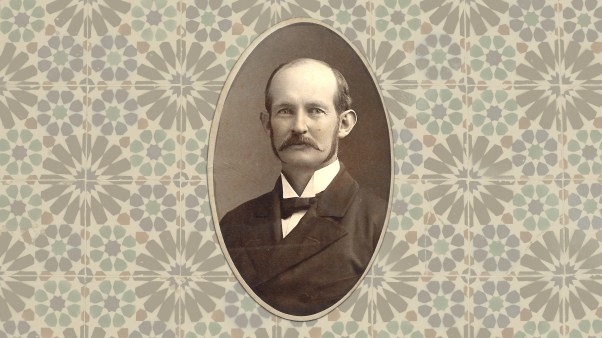A blueprint for moral education in a pluralistic age.
Are America’s public schools graduating a generation of moral illiterates? The question has stirred intense public debate. One educator joining the chorus of questioners is Christina Hoff Sommers. Fifteen years of teaching ethics at the university level has convinced Sommers that something in the classroom has gone fundamentally wrong. “We may be one of the few societies in the world that finds itself incapable of passing on its moral teachings to young people,” she told CT. When it comes to character development and moral education, it is as though “we’ve forgotten several thousand years of civilization—the great moral, religious, and philosophical traditions.”
Two experiences in particular convinced Sommers that public education must find a better way. One was becoming a parent. She saw firsthand how public schools retreat from the “traditional task of helping parents to civilize the child.” She therefore felt grateful to be able to enroll her child in a private Jewish school where the teaching staff was “not afraid to teach ethics and kindness, where morality was woven into the daily lessons.”
What she saw in her college students was just as unsettling. She came face to face with a “surprising number of young people who think there’s no right or wrong, that moral choices depend on how you feel.” While many were decent and kind, and “the vast majority could never really harm another person or steal, they could not justify or defend ethical values.” They had no sense that morality could be normative and absolute.
While Sommers realizes that separation of church and state may not encourage the use of specifically religious texts in government schools, she does believe educators can do a great deal more than they do. Western philosophy, much of it with roots in Judeo-Christian teachings, can prompt classroom discussion in which teachers insist on certain kinds of behavior and “cultivate what Aristotle called a love of the good.” Even classics of literature from the likes of Tolstoy or Shakespeare, she believes, can yield insight in ethical living, if educators will only shed their moral relativism.
Here Sommers gets specific about what that means for classrooms across the land.
Some time ago, I published an article titled “Ethics Without Virtue,” in which I criticized the way ethics is being taught in American colleges. I pointed out that students taking college ethics classes debate abortion, euthanasia, capital punishment, DNA research, and the ethics of transplant surgery, while they learn almost nothing about private decency, honesty, personal responsibility, or honor. I argued that the current style of teaching ethics, which concentrates so much on social policy, is giving students the wrong ideas about ethics. Social morality is only half of the moral life; the other half is private morality. I urged that we attend to both.
A colleague of mine did not like what I said. She told me that in her classroom, she would continue to focus on issues of social injustice—women’s oppression, corruption in big business, transgressions of multinational corporations in Third World countries. She explained, “You are not going to have moral people until you have moral institutions. You will not have moral citizens until you have a moral government.” She made it clear that I was wasting time and even doing harm by promoting bourgeois virtues and not awakening the social conscience of my students.
At the end of the semester, she came into my office carrying a stack of exams and looking very upset.
“What’s wrong?” I asked.
“They cheated on their social justice take-home finals. They plagiarized!” More than half of the students in her ethics class had copied long passages from the secondary literature.
“What are you going to do?” I asked. She gave me a self-mocking smile and said, “I’d like to borrow a copy of that article you wrote on ethics without virtue.”
Cheating has plagued many of our best universities. A recent survey reported in the Boston Globe says that 50 percent of all college students admit to cheating; for high-school students, the figure is 75 percent. A U.S. News & World Report survey asked college-age students if they would steal from an employer. Thirty-four percent said they would.
Many people come to college dogmatically committed to a moral relativism that offers them no grounds to think that cheating is simply wrong. With first-year students, I often have them try to find some act they will condemn as morally wrong. The reply is often, “Torture, starvation, and humiliation may be bad for you or me, but who are we to say they are bad for someone else?”
Of course, not all students are dogmatic relativists, nor cheaters and liars. Even so, it is impossible to deny that students’ ability to arrive at reasonable moral judgments is being severely, even bizarrely, affected. A few years ago, a Harvard University professor, who annually offers a class on the Second World War and the rise of the Nazis, was stunned to learn that the majority of his students did not believe anyone was really to blame for the Holocaust. In the students’ minds, the Holocaust was like a natural cataclysm: It was inevitable and unavoidable. The professor refers to his students’ attitude about the past as “no-fault history.”
What’s gone wrong in class
In nineteenth-century America, the ethics course was a high point of college life. It was taken in a senior year and was usually taught by the president of the college, who would uninhibitedly urge the students to become morally better and stronger. The senior ethics course was, in fact, the culmination of the students’ college experience. But as the social sciences began to flourish in the early twentieth century, ethics courses gradually lost prominence until they became just one of several electives offered by philosophy departments. By the mid-1960s, enrollment in courses on moral philosophy reached an all-time high.
At the end of the 1960s, there was a rapid turnaround. To the surprise of many a department chair, applied-ethics courses suddenly proved to be very popular. Philosophy departments began to attract unprecedented numbers of students to courses in medical ethics, business ethics, ethics for everyday life, ethics for lawyers, for social workers, for nurses, for journalists. More recently, the dubious behavior of some politicians and financiers has added to public concern over ethical standards, which in turn has contributed to the feeling that college ethics is needed. Today American colleges and universities are offering thousands of well-attended courses in applied ethics.
I, too, have been teaching applied-ethics classes for several years. Yet my enthusiasm tapered off when I saw how the students reacted. I was especially disturbed by comments students made again and again on the course evaluation forms: “I learned there was no such thing as right or wrong, just good or bad arguments.” Or: “I learned there is no such thing as morality.” I asked myself what it was about these classes that was fostering this sort of moral agnosticism and skepticism. Perhaps the students themselves were part of the problem. Perhaps it was their high-school experience that led them to become moral agnostics. Even so, I felt that my classes were doing nothing to change them.
The course I had been giving was altogether typical. At the beginning of the semester we studied a bit of moral theory, then took up topical moral issues such as abortion, censorship, capital punishment, world hunger, and affirmative action. Naturally, I felt it was my job to present careful and well-argued positions on all sides of these issues. But this atmosphere of argument and counterargument was reinforcing the idea that all moral questions have at least two sides, that all ethics is controversial.
Perhaps this reaction is to be expected. In a course specifically devoted to dilemmas and hard cases, it is almost impossible not to give the student the impression that ethics itself has no solid foundation.
On not being bullied
The relevant distinction here is between “basic” ethics and “dilemma” ethics. It is basic ethics that G. J. Warnock has in mind when he warns his fellow moral philosophers not to be bullied out of holding fast to the “plain moral facts.” Because the typical course in applied ethics concentrates on problems and dilemmas, the students may easily lose sight of the fact that some things are clearly right and some clearly wrong, that some ethical truths are not subject to serious debate.
I recently said something to this effect during a television interview in Boston, and the skeptical interviewer immediately asked me to name some uncontroversial ethical truths. After stammering for a moment, I found myself rattling off several that I hold to be uncontroversial: It is wrong to mistreat a child, to humiliate someone, to torment an animal, to think only of yourself, to steal, to lie, to break promises. And on the positive side: It is right to be considerate and respectful of others, to be charitable and generous.
I am aware that not everyone will agree that all of these are plain moral facts. But in teaching ethics, one thing should be made central and prominent: Right and wrong do exist. This should be laid down as uncontroversial lest one leave an altogether false impression that everything is up for grabs.
The average student today does not come to college steeped in a religious or ethical tradition in which he or she has uncritical confidence. In the atmosphere of a course dealing with hard and controversial cases, the student may find the very idea of a stable moral tradition to be an archaic illusion. I am suggesting that we have some responsibility for providing the student with what the philosopher Henry Sidgwick called “moral common sense.” I am also suggesting that we assess some of the courses we teach for their edificatory effect. Our responsibility as teachers goes beyond purveying information about the leading ethical theories and developing dialectical skills. Dilemma ethics is especially lacking in edificatory force and may even encourage a superficial moral relativism or agnosticism.
I will not really argue the case for seeing the responsibility of the teacher of ethics in traditional terms. But the burden of argument belongs to those who maintain that modern teachers of ethics should abjure the teacher’s traditional concern with edification. Moreover, it seems to me that the hands-off posture is not really as neutral as it professes to be. Author Samuel Blumenfeld is even firmer on this point. He says, “You have to be dead to be value-neutral.” In tacitly or explicitly promoting the doctrine that there are no “plain moral facts,” the teacher condones the student’s lack of confidence in a moral life that could be grounded in something more than personal disposition or political fashion. I am convinced that we could be doing a far better job of moral education.
Aristotle and relativism
If one accepts the idea that moral edification is appropriate in teaching ethics, then the question arises: What sorts of courses in ethics are effective? What ethical teachings are naturally edificatory? My own experience leads me to recommend a course on the philosophy of virtue. And Aristotle is a good place to begin.
Exposure to Aristotle makes an immediate inroad on dogmatic relativism; indeed, the tendency to discuss morality as relative to taste or social fashion rapidly diminishes and may vanish altogether. Students find a great deal of plausibility in the philosopher’s theory of moral education, as well as personal relevance in what he says about courage, generosity, temperance, and other virtues.
Once the student becomes engaged with the problem of what kind of person to be, and how to become that kind of person, the problems of ethics become concrete and practical, and, for many a student, moral development is thereafter looked on as a natural, even inescapable, undertaking. And though the writings of Aristotle and of other philosophers of virtue are full of argument and controversy, students who read them with care are not tempted to say they learned “there is no right or wrong, only good or bad arguments.”
At the elementary and secondary level, students may be too young to study the philosophy of virtue, but they certainly are capable of reading stories and biographies about great men and women. Unfortunately, today’s primary-school teachers, many of whom are heavily influenced by what they were taught in trendy schools of education, make little use of the time-honored techniques of telling a story and driving home “the moral of the story.” What are they doing, instead?
Values obfuscation
One favored method of moral education that has been popular for the past 20 years is called “values clarification,” which maintains the principle that the teacher should never directly tell students about right and wrong; instead, the students must be left to discover “values” on their own.
One values-clarification technique is to ask children questions about their likes and dislikes, to help them become acquainted with their own personal preferences. The students’ reactions to these wide-ranging questions—from “What is your favorite color?” to “How do you feel about hit-and-run drivers?”—are elicited from them in the same tone of voice, as if one’s personal preferences in both instances are all that matter.
One of my favorite anecdotes concerns a teacher in Massachusetts who had attended numerous values-clarification workshops and was assiduously applying their techniques in her class. The day came when her sixth-graders announced that they valued cheating and wanted to be free to do it on their tests. The teacher was very uncomfortable. Her solution? She told the children that since it was her class and since she was opposed to cheating, they were not free to cheat. “I personally value honesty; although you may choose to be dishonest, I shall insist that we be honest on our tests here. In other areas of your life, you may have more freedom to be dishonest.”
Now this sincere teacher was doing her best not to indoctrinate her students. But what she was telling them is that cheating is not wrong if you can get away with it. Good values are “what one values.” She valued the norm of not cheating. That made this value binding on her and gave her the moral authority to enforce it in her classroom; others, including the students, were free to choose other values “in other areas.” The teacher thought she had no right to intrude by giving the students moral direction. Of course, the price for her failure to do her job of inculcating moral principles is ultimately paid by her bewildered students, who are being denied a structured way to develop values.
This Massachusetts teacher values honesty, but her educational theory does not allow her the freedom to take a strong stand on honesty as a moral principle. Her training has led her to treat her “preference” for honesty as she treats her preference for vanilla-over chocolate-flavored ice cream. It is not hard to see how this doctrine is an egoistic version of ethical relativism.
How sad that so many teachers feel intellectually and “morally” unable to justify their own belief that cheating is wrong. It is obvious that our schools must have clear behavior codes and high expectations for their students. Civility, honesty, and considerate behavior must be recognized, encouraged, and rewarded. That means that moral education must have as its explicit aim the moral betterment of the student. If that be indoctrination, so be it. How can we hope to equip students to face the challenge of moral responsibility in their lives if we studiously avoid telling them what is right and what is wrong?
The elementary schools of Amherst, New York, provide good examples of an unabashedly directive moral education. Posters are placed around the school extolling kindness and helpfulness. Good behavior in the cafeteria is rewarded with a seat at a “high table” with tablecloth and flowers. One kindergarten student was given a special award for having taken a new Korean student under her wing. But such simple and reasonable methods as those practiced in Amherst are rare. Many school systems have entirely given up the task of character education. Children, having been denied access to moral knowledge, are left to fend for themselves.
But the question comes again: Is there really such a thing as moral knowledge? The reply to that is an emphatic yes. Have we not learned a thing or two over the past several thousand years of civilization? To pretend we know nothing about basic decency, about human rights, about vice and virtue, is fatuous or disingenuous. Of course we know that gratuitous cruelty and political repression are wrong, that kindness and political freedom are right and good. Why should we be the first society in history that finds itself hamstrung in the vital task of passing along its moral tradition to the next generation?
Some opponents of directive moral education argue that it could be a form of brainwashing. That is a pernicious confusion. To brainwash is to diminish someone’s capacity for reasoned judgment. It is perversely misleading to say that helping children to develop habits of truth-telling or fair play threatens their ability to make reasoned choices. Quite the contrary: Good moral habits enhance one’s capacity for rational judgments.
The paralyzing fear of indoctrinating children is even greater in high schools than in elementary schools. One favored high-school teaching technique that allegedly avoids indoctrination of children—as it allegedly avoids indoctrination of college students—is dilemma ethics. Children are presented with abstract moral dillemmas: seven people are in a lifeboat with provisions for four; what should they do? Or there is developmental theorist Lawrence Kohlberg’s famous case of Heinz and the stolen drug. Should the indigent Heinz, whose dying wife needs medicine, steal it? When high school students study ethics at all, it is usually in the form of pondering such dilemmas or in the form of debates on social issues: abortion, euthanasia, capital punishment, and the like. Directive moral education is out of favor. Storytelling is out of fashion.
Who is the hero?
Let’s consider just how the current fashion in dilemmas differs from the older approach to moral education, which often used tales and parables to instill moral principles. Novelist Saul Bellow, for example, asserts that the survival of Jewish culture would be inconceivable without the stories that give point and meaning to the Jewish moral tradition. One such story, included in a collection of traditional Jewish tales that Bellow edited, is called “If Not Higher.” I sketch it here to contrast the story approach with the dilemma approach.
There was once a rabbi in a small Jewish village in Russia who vanished every Friday for several hours. The villagers boasted that during these hours their rabbi ascended to heaven to talk with God. A skeptical newcomer arrived in town, determined to discover where the rabbi really was.
One Friday morning the newcomer hid near the rabbi’s house, watched him rise, say his prayers and put on the clothes of a peasant. He saw him take an ax and go into the forest, chop down a tree, and gather a large bundle of wood.
The rabbi proceeded to a shack in the poorest section of the village in which lived an old woman. He left her the wood, which was enough for the week. The rabbi then quietly returned to his own house.
The story concludes:
The newcomer stayed on in the village and became a disciple of the rabbi. And whenever he hears one of his fellow villagers say, “On Friday morning our rabbi ascends all the way to heaven,” the newcomer quietly adds, “If not higher.”
In a moral dilemma such as Kohlberg’s Heinz stealing the drug, or the lifeboat case, there are no obvious heroes or villains. Not only do the characters lack moral personality, but they exist in a vacuum outside of traditions and social arrangements that shape their conduct in the problematic situations confronting them. In a dilemma, there is no obvious right and wrong, no clear vice and virtue. It may engage the students’ minds, but it only marginally engages their emotions and moral sensibilities. The issues are finely balanced, listeners are on their own, and they individually decide for themselves. As one critic of dilemma ethics has observed, one cannot imagine parents passing down to their children the tale of Heinz and the stolen drug. By contrast, in the story of the rabbi and the skeptical outsider, it is not up to the listener to decide whether or not the rabbi did the right thing. The moral message is clear: “Here is a good man—merciful, compassionate, and actively helping someone weak and vulnerable. Be like that person.” The message is contagious. Even the skeptic gets the point.
Stories and parables are not always appropriate for high-school or college ethics courses, but the literary classics certainly are. To understand King Lear, Oliver Twist, or Huckleberry Finn requires that the reader have some understanding of (and sympathy with) what the author is saying about the moral ties that bind the characters and that hold in place the social fabric in which they play their roles. Literary figures can thus provide students with the moral paradigms that Aristotle thought were essential to moral education.
Hungry for moral sustenance
I am not suggesting that moral puzzles and dilemmas have no place in the ethics curriculum. To teach something about the logic of moral discourse and the practice of moral reasoning in resolving conflicts of principles is clearly important. But dilemmas are not the place to start, and, taken by themselves, provide little or no moral sustenance. Moreover, an exclusive diet of dilemma ethics tends to give the student the impression that ethical thinking is a lawyer’s game.
So where do we start? What I am recommending is not new. It has worked before and is simple:
1. Schools should have behavior codes that emphasize civility, kindness, self-discipline, and honesty.
2. Teachers should not be accused of brainwashing children when they insist on basic decency, honesty, and fairness.
3. Children should be told stories that reinforce goodness. In high school and college, students should be reading, studying, and discussing the moral classics.
I am suggesting that teachers must help children become acquainted with their moral heritage in literature, religion, and philosophy. I believe that virtue can be taught and that effective moral education appeals to the emotions as well as to the mind. The best moral teaching inspires students by making them keenly aware that their own character is at stake.
Loren Wilkinson is the writer/editor of Earthkeeping in the ’90s (Eerdmans) and the coauthor, with his wife, Mary Ruth Wilkinson, of Caring for Creation in Your Own Backyard (Servant). He teaches at Regent College in Vancouver, British Columbia, Canada.










